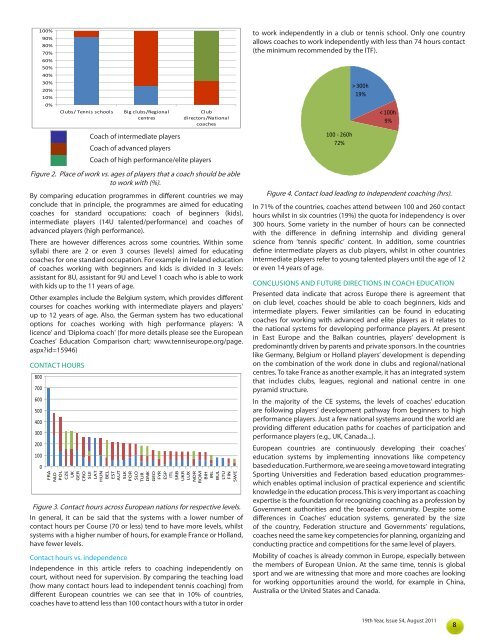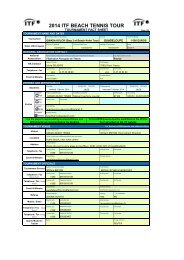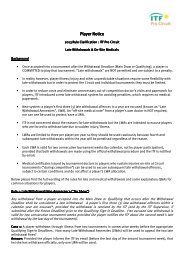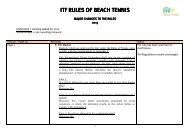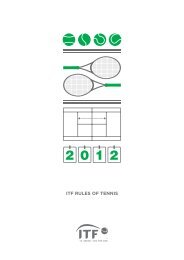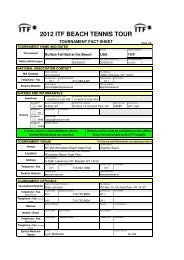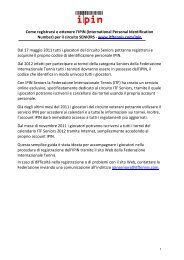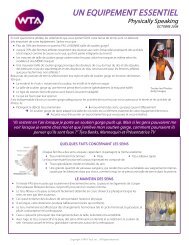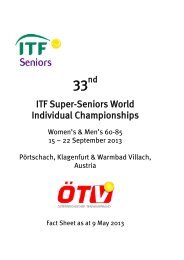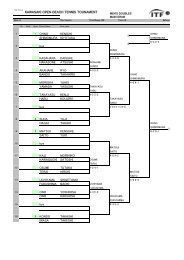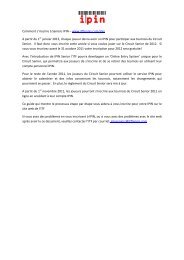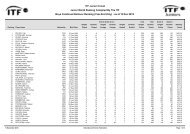Coaching & Sport Science Review - International Tennis Federation
Coaching & Sport Science Review - International Tennis Federation
Coaching & Sport Science Review - International Tennis Federation
You also want an ePaper? Increase the reach of your titles
YUMPU automatically turns print PDFs into web optimized ePapers that Google loves.
100%<br />
90%<br />
80%<br />
70%<br />
60%<br />
50%<br />
40%<br />
30%<br />
20%<br />
10%<br />
0%<br />
Clubs/ <strong>Tennis</strong> schools Big clubs/Regional<br />
centres<br />
Coach of intermediate players<br />
Coach of advanced players<br />
Club<br />
directors/National<br />
coaches<br />
Coach of high performance/elite players<br />
Figure 2. Place of work vs. ages of players that a coach should be able<br />
to work with (%).<br />
By comparing education programmes in different countries we may<br />
conclude that in principle, the programmes are aimed for educating<br />
coaches for standard occupations: coach of beginners (kids),<br />
intermediate players (14U talented/performance) and coaches of<br />
advanced players (high performance).<br />
There are however differences across some countries. Within some<br />
syllabi there are 2 or even 3 courses (levels) aimed for educating<br />
coaches for one standard occupation. For example in Ireland education<br />
of coaches working with beginners and kids is divided in 3 levels:<br />
assistant for 8U, assistant for 9U and Level 1 coach who is able to work<br />
with kids up to the 11 years of age.<br />
Other examples include the Belgium system, which provides different<br />
courses for coaches working with intermediate players and players'<br />
up to 12 years of age. Also, the German system has two educational<br />
options for coaches working with high performance players: 'A<br />
licence' and 'Diploma coach' (for more details please see the European<br />
Coaches’ Education Comparison chart; www.tenniseurope.org/page.<br />
aspx?id=15946)<br />
CONTACT HOURS<br />
800<br />
700<br />
600<br />
500<br />
400<br />
300<br />
200<br />
100<br />
0<br />
FRA<br />
NLD<br />
POL<br />
CZE<br />
UK<br />
GER<br />
CRO<br />
SUI<br />
LAT<br />
HUN<br />
BEL<br />
EST<br />
AUT<br />
SLK<br />
POR<br />
SLO<br />
TUR<br />
DNK<br />
GEO<br />
FYR<br />
ESP<br />
ITL<br />
SRB<br />
UKR<br />
LUX<br />
NOR<br />
ROM<br />
BIH<br />
IRL<br />
BUL<br />
LTU<br />
FIN<br />
SWE<br />
Figure 3. Contact hours across European nations for respective levels.<br />
In general, it can be said that the systems with a lower number of<br />
contact hours per Course (70 or less) tend to have more levels, whilst<br />
systems with a higher number of hours, for example France or Holland,<br />
have fewer levels.<br />
Contact hours vs. independence<br />
Independence in this article refers to coaching independently on<br />
court, without need for supervision. By comparing the teaching load<br />
(how many contact hours lead to independent tennis coaching) from<br />
different European countries we can see that in 10% of countries,<br />
coaches have to attend less than 100 contact hours with a tutor in order<br />
to work independently in a club or tennis school. Only one country<br />
allows coaches to work independently with less than 74 hours contact<br />
(the minimum recommended by the ITF).<br />
100 - 260h<br />
72%<br />
> 300h<br />
19%<br />
< 100h<br />
9%<br />
Figure 4. Contact load leading to independent coaching (hrs).<br />
In 71% of the countries, coaches attend between 100 and 260 contact<br />
hours whilst in six countries (19%) the quota for independency is over<br />
300 hours. Some variety in the number of hours can be connected<br />
with the difference in defining internship and dividing general<br />
science from ‘tennis specific’ content. In addition, some countries<br />
define intermediate players as club players, whilst in other countries<br />
intermediate players refer to young talented players until the age of 12<br />
or even 14 years of age.<br />
CONCLUSIONS AND FUTURE DIRECTIONS IN COACH EDUCATION<br />
Presented data indicate that across Europe there is agreement that<br />
on club level, coaches should be able to coach beginners, kids and<br />
intermediate players. Fewer similarities can be found in educating<br />
coaches for working with advanced and elite players as it relates to<br />
the national systems for developing performance players. At present<br />
in East Europe and the Balkan countries, players’ development is<br />
predominantly driven by parents and private sponsors. In the countries<br />
like Germany, Belgium or Holland players’ development is depending<br />
on the combination of the work done in clubs and regional/national<br />
centres. To take France as another example, it has an integrated system<br />
that includes clubs, leagues, regional and national centre in one<br />
pyramid structure.<br />
In the majority of the CE systems, the levels of coaches’ education<br />
are following players’ development pathway from beginners to high<br />
performance players. Just a few national systems around the world are<br />
providing different education paths for coaches of participation and<br />
performance players (e.g., UK, Canada...).<br />
European countries are continuously developing their coaches’<br />
education systems by implementing innovations like competency<br />
based education. Furthermore, we are seeing a move toward integrating<br />
<strong>Sport</strong>ing Universities and <strong>Federation</strong> based education programmes-<br />
which enables optimal inclusion of practical experience and scientific<br />
knowledge in the education process. This is very important as coaching<br />
expertise is the foundation for recognizing coaching as a profession by<br />
Government authorities and the broader community. Despite some<br />
differences in Coaches’ education systems, generated by the size<br />
of the country, <strong>Federation</strong> structure and Governments’ regulations,<br />
coaches need the same key competencies for planning, organizing and<br />
conducting practice and competitions for the same level of players.<br />
Mobility of coaches is already common in Europe, especially between<br />
the members of European Union. At the same time, tennis is global<br />
sport and we are witnessing that more and more coaches are looking<br />
for working opportunities around the world, for example in China,<br />
Australia or the United States and Canada.<br />
19th Year, Issue 54, August 2011<br />
8


